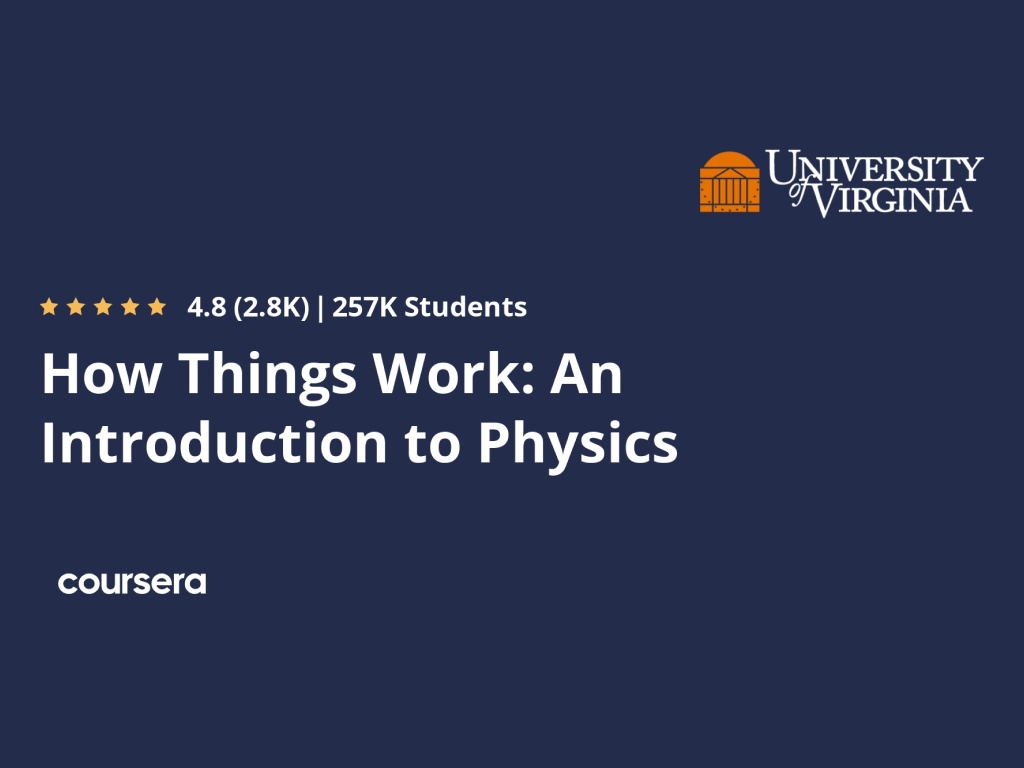An introduction to physics in the context of everyday objects.
Moocable is learner-supported. When you buy through links on our site, we may earn an affiliate commission.
Syllabus
- Course Introduction
- Start here!
- Skating
- Professor Bloomfield examines the principle of inertia through skate boarding. Objects at rest tend to remain at rest while objects in motion, tend to remain in motion. Why does a stationary skater remain stationary? Why does a moving skater tend to continue moving? How can we describe the fluid, effortless motion of a coasting skater? How does a skater start, stop, or turn? Why does a skater need ice or wheels in order to skate? Physics concepts covered include Newton's first and second laws and 5 physical quantities: position, velocity, acceleration, force, and mass.
- Falling Balls
- Professor Bloomfield examines the physics concepts of gravity, weight, constant acceleration, and projectile motion working with falling balls.
- Ramps
- Professor Bloomfield examines the physics concepts of Newton's third law including conserved quantities, support forces, work, energy, and mechanical advantage working with ramps.
- Seesaws
- Professor Bloomfield illustrates the physics concepts of rotational versus translational motion, Newton's law of rotation, and 5 physical quantities: angular position, angular velocity, angular acceleration, torque, and rotational mass using seesaws.
- Wheels
- Professor Bloomfield illustrates the physics concept of frictional forces through experiments with wheels.
- Bumper Cars
- Professor Bloomfield examines the physics concepts of momentum, impulse, angular momentum, angular impulse, and the relationship between potential energy and force using bumper cars.
- Final
- This is the final exam.

How Things Work: An Introduction to Physics
Affiliate notice
-
TypeOnline Course
-
Provider
-
PricingFree to Audit
-
CertificatePaid certificate
An introduction to physics in the context of everyday objects.
- Course Introduction
- Start here!
- Skating
- Professor Bloomfield examines the principle of inertia through skate boarding. Objects at rest tend to remain at rest while objects in motion, tend to remain in motion. Why does a stationary skater remain stationary? Why does a moving skater tend to continue moving? How can we describe the fluid, effortless motion of a coasting skater? How does a skater start, stop, or turn? Why does a skater need ice or wheels in order to skate? Physics concepts covered include Newton's first and second laws and 5 physical quantities: position, velocity, acceleration, force, and mass.
- Falling Balls
- Professor Bloomfield examines the physics concepts of gravity, weight, constant acceleration, and projectile motion working with falling balls.
- Ramps
- Professor Bloomfield examines the physics concepts of Newton's third law including conserved quantities, support forces, work, energy, and mechanical advantage working with ramps.
- Seesaws
- Professor Bloomfield illustrates the physics concepts of rotational versus translational motion, Newton's law of rotation, and 5 physical quantities: angular position, angular velocity, angular acceleration, torque, and rotational mass using seesaws.
- Wheels
- Professor Bloomfield illustrates the physics concept of frictional forces through experiments with wheels.
- Bumper Cars
- Professor Bloomfield examines the physics concepts of momentum, impulse, angular momentum, angular impulse, and the relationship between potential energy and force using bumper cars.
- Final
- This is the final exam.
Tags
Loading...
Saving...
Loading...

 Online Course
Online Course 
 Free to Audit
Free to Audit  Paid certificate
Paid certificate